Want to make your site in unique and unique, then you need to plant a skimpy. This exotic plant has simply chic appearance: a large number of green foliage, small flowers and an air pink wig after flowering.
It is all these decorative features that make it possible to create interesting garden compositions with a single plant. Skumpiya, landing and care for which will not be difficult even for an inexperienced gardener, will become a real queen of your garden.
In this article, we will consider in more detail all the features and description of the scum, we learn about all the most popular and common types and varieties of this unique plant. We will help you deal with all the nuances of the agrotechnology of growing a "wiggy" tree.
Features and description of skumpics
Skumpiya is a plant that is not so often you can meet on household plots in our area. An exotic bush or tree is not deserved deprived by the attention of gardeners, because such an amazing plant, thanks to its bright appearance, will become a unique decoration of any garden.
Skumpia is a leaf falling shrub and belongs to the Summy family. The habitat of this plant is rather scattered. This is associated with the latest icing, which has been separated by two main types in different parts of the world.
This plant has a lot of names that he was assigned because of his appearance and various features. The most popular is a wicking tree. He received a screaming for the appearance on his branches of long bracts, which after flowering rapidly grow and are punching pink hair, so similar to a wig.
A dyeing tree or a tanning tree is another fairly common names of skumpia. It received them this plant for the content of organic dyes in foliage and roots, as well as for using it for the selection of leather due to the presence of tannins.
The modern name of the scum, which spread through the territory of Russia, is considered to be skumatic. It went from the Moldovan word "skirmish", which means "expensive".
The birthplace of skumpia is considered to be the territory of Eurasia with a temperate climate (Caucasus, Mediterranean, China, Crimea) and North America. From here and the presence of two main species of this plant: leather and American. In the middle of the 17th century in the middle of the 17th century, Russia fell into the territory of Russia.
Description of skumpia:
- In nature, it can occur in the form of a leaf falling shrub or a tree, it all depends on the specific type and variety. Cultivated types of skumpics grow in the form of miniature and elegant bushes and rarely grow high.
- Skumpiya prefers to grow in southern areas, so even in Russia, it is possible to meet it in a softer climate zones - in the Caucasus, in the Crimea.
- It is a very branched shrub, which in a decorative one can reach a height of 2-3 meters, in nature, especially in subtropics, there are copies of up to 10 meters in height.
- It is formed green or slightly reddish shoots that can sometimes be sowned.
- Skump leaves are one of the decorative values. They are simple labeling oval ovoid shapes that are attached to the shoots on long stiffs. They are slightly leathery and have various shades. During vegetation, it is distinguished by a sizo green or sizo-reddish color, and after flowering, the leaves of the scum can be violet, purple or orange.
- It blooms this unusual shrub from the beginning of the summer with small greenish or greenish-yellow flowers, which are assembled in the delicate bundled inflorescences that reach a length of 30 cm.
- After flowering, all the flowers are flying and staying on the branches only fruits or flowers, which quickly begin to grow and be covered with a pink pile. It is thanks to these red threads, the entire bush is covered with an air and lace cloud, which is so similar to a wig. Such an appearance of the scamps decorates the garden until December.
- The fruit of skumpia is a green bone, which then draws.
- This shrub is a long-liver - on average, each skumpium can live up to 100 years.
- Currently, there are two types of skumpius, there has been great popularity in Russia or tapering.
- Skumpiya also has several popular forms: sharpening, wearing, swallowing and green.
Popular species and varieties of skumpies
Undoubtedly, leather skumpia received great popularity in Russia. This type of shrub has several varieties that differ in their unique features and decorative value. Let us consider in more detail the distinguishing features of each type and highlight the main varieties of skumpics.
Skumpia leather green
This kind of skin skumpia is one of the most decorative. Emerald magnificent bushes can often be found in areas and in the gardens. Skumpiya Green is an ideal plant for our climatic conditions, as it is characterized by good endurance to the cold and unpretentious in care. It grows in the form of a deciduous shrub, which height can reach 3-5 meters. Leaves are distinguished by green color. Decorative value has the inflorescences of green skumpics, which throughout the growing season change their color. First they are green, then become yellow, after which they change the color on pink and crimson. You can see the effectiveness of the green skin skumpie in the photo.
Green leather skumpius varieties:
- "Young Lady". This variety is the most popular and distinguished by a constant green foliage that does not change the color even in the fall. Height can reach 4 meters. It looks very interesting in landscape design due to changing coloring inflorescences with green on pink. In one place such a shrub grows up to 60 years.
- "Green Fountain". Shrub with green foliage, which practically does not change its painting. Only in the fall you can notice a little yellow foliage. It does not end the cold, so it is not very popular among the gardeners of Russia.
Skumpius leather red-beard
This type of skirmism is distinguished by bright red foliage, which is an important decorative value. However, in Russia, this species stuck weakly, as it does not differ in good endurance and often does not carry strong frosts, even with careful shelter.
Popular varieties of scum red:
- Purple scamps. A very spectacular shrub, which in height reaches 7-8 cm. Its main decoration is purple foliage and lush purple inflorescences.
- Piano Piano Skump. This is another popular type of redtime skimpy. It differs not very high increasing, can grow only 1.5 m. Pretty slowly grows. The foliage is large, painted in the summer in a reddish color, and in the fall it becomes with a small silver tint. Skumpiya Royal in one place can grow up to 70 years. However, Russia does not move very well, may die from winter frosts.
- Grace. Another bright representative of this type of skirmism. May grow in culture up to 5 meters. The main decorative value is large soft leaves that are painted in a bright purple color. At autumn, the entire bush becomes scarlet, as if they are free.
Skump of leather Koggriy
This representative of the skumpia also did not particularly fit into our territories because of their poor peely tolerance. It is more natural form and is distinguished by bright yellow foliage.
Popular Coggriy Skump:
- "Golden Spirit". This variety of skumpia is vividly highlighted with golden yellow foliage, which in shape resembles coins. By autumn, the color of foliage changes partly on orange and reddish.
These species are the most popular on the territory of Russia, therefore, in the future, we will stay in more detail on the agricultural engineering of growing skirts of the leather.
Methods of breeding skumpia
Skipping leather breeds breeds seeds and vegetatively, so you can easily pick up the method most suitable for you.
Reproduction of skumpius seeds
This is a rather time-consuming method of breeding, as it is very difficult to get seeds of this shrub. Fruit once in a few years, they usually ripen at the end of summer. The seed method is used very rarely, most often by breeders, since the grown plants with this method do not retain parental signs.
- Seeds can be sung immediately after collecting, pre-holding them in a solution of sulfuric acid. Next, in the fall they are seeded immediately into the ground, blocking 2 cm. Frosts will help them germinate faster.
- If you decide to plant seeds in the spring, then it is necessary to subjected to their stratification process, i.e. Turn cold for several months.
- Previously, it is also necessary to place the seeds of the scum in a solution of sulfuric acid for softening the shell so that they are faster sprouted.
- After that, the planting material is placed in a container with wet soil and put into a room or a refrigerator with a temperature of 3-5 degrees.
- In the spring you can start cropping. The first shoots will appear only in a year.
Reproduction of skumpia cuttings
This method is also considered not quite simple.
- Green cuttings are harvested in June-July.
- To do this, choose a healthy and strong plant. Cuttings must be 15-20 cm with several kidneys.
- Bottom leaves must be cut off.
- At night, you can put a cutlery into a container with a solution of a stimulator of the root formation, not less than 12 hours.
- Then prepare the soil for rooting, which should consist of equal parts of sand, peat and turf.
- The cuttings are placed in lightness in greenhouse conditions for rooting.
- Further care consists in constant ventilation and daily watering or spraying.
- However, the survival rate of cuttings is not very high - only 30%.
Reproduction by chains
Skump can be multiplied with the tanks, with this method is considered the easiest and fast.
- For this spring on a healthy bush need to choose the lowest branch close to the ground.
- Then retreat 40 cm from its edge and make a longitudinal incision on the root of a sharp knife.
- After that, gently press the branch to the ground and attach it.
- Fall asleep with the prepared ground with the door and rolling through the water.
- further care consists in constant watering.
- After rooting, you will need to disconnect the young plant from maternal and transplant to a permanent place.
Reproduction of pigs
Periodically, young bushes can be formed on the root system of adult plants. which can be easily separated and transplant to a permanent place. It is necessary to separate it carefully, so as not to damage the roots.
Preparation before planting skumpia
To get a beautiful and strong Kusta skumpia, it is important to carefully prepare. Be sure to carefully select a good planting material, healthy and without damage. Not unimportant is the choice of the right place to plant skumpies, as well as high-quality soil preparation.
Selection of saplings skumpia
A good planting material is a guarantee of receiving a beautiful and blooming bush in the future. Most often, the saplings of skumpies are purchased in specialized stores and nurseries. The price of them is satisfied high, so you need to go to the selection very carefully. Be sure to buy seedlings with a closed root system, so you can plant a skimpy at a convenient time for you. Spend a thorough inspection of shoots and leaves - they should not be damaged.
Avoid purchasing saplings of scum in various markets, in roads and strangers. In such cases, you risk buying not exactly what you want.
Selection of places for landing
Skumpiya prefers to grow on light and sunny places. Be sure to pick up a plot that will be protected from the winds and is fully open to sunlight. Admission easy half, but it should not be excessive, since the plant may not have time to graze to cold. It is desirable that the big and high trees that are able to create a shadow are preserved near the scum.
It is also important to take into account that the scum does not make close to groundwater. Therefore, choose a plot for landing on a small elevation or create a good layer of drainage.
When choosing a place for planting skumpies, consider the plan for the garden composition you want to get in the end. Skump can be planted as a living hedge or use for a single landing.
Soil preparation for landing
This culture grows perfectly on alkaline soils, which perfectly skip air and water. Weakly soils, delicate, drunken, soup, forest land can also be suitable. Before boarding, it is important to carefully step down the selected area so that the soil is light and air.
The process of landing skimpics of leather
The landing time depends on the season, you can land in early spring or autumn. The main thing is to plant at the right moment, so that the scum will have to be rooted and grapple before the onset of frosts or summer heat. The root system of acquired seedlings also affects the choice of landing time. If you bought the boarding material with an open root system, then it is necessary to plant them in open soil without postponing. Saplings with closed roots can be stored in containers for a long time.
- At the selected place, it is necessary to switch the soil well, making it loose and easy.
- Fertilizers do not necessarily, you can also not mix a special soil mixture. Although there is a brighter and magnificent plant on the nutrient soil.
- Next, you need to prepare landing wells, the size of which should exceed the size of the root system with an earth's room. If you sit down several bushes in one row, be sure to indent themselves between the pitches of at least 1-1.5 m.
- Saplings of skumpics Previously need to carefully remove from the container. It doesn't need to touch the earth to touch the root system.
- In the landing well at the bottom, create a drainage layer to prevent stagnation of water from the roots. As a drainage, you can use small stone, broken brick or clay.
- On the drainage layer, put a small soil hilly.
- Next, gently put the seedlings into the boarding holes and sprinkle the earth. Slightly endure the soil around the seedling.
- When landing, consider that the root cerv should be higher than the soil level by 2-3 cm.
- Abundantly pour all seedlings with water.
Features of the care of skumpay
The care for leather skumpay is not much difficult, even a beginner and inexperienced gardener will cope with all processes. It is important to periodically water, crop and loose soil. As a result, on its site you will get a beautiful and magnificent flowering tree of skumpia.
Watering skumpia
Skumpia requires moderate watering. She better tolerate a little drought than the overvailing. This is connected with the long rod root system of this plant, which is able to produce water deep in the ground. At the same time, the upper part of the earth can be dry. With enough wet weather during spring and summer, watering can be excluded altogether.
Loosening and mulching
Periodically, you will need soil looser in the rolling collar and the removal of weeds. This will contribute to the saturation of soil with oxygen, which makes it light and air. After loosening, the rolling circle can be meditated to prevent excessive evaporation of moisture and the appearance of weeds. As a mulch, you can use dry peat, dry wood sawdust or bark.
Podchar
Skumpia does not require fertilizer, it does not tolerate excess of organic and minerals. For normal growth of culture is sufficient one feeding in the spring complex fertilizer. If your skirmism grows on poor soils, in the spring, support it with nitrogen fertilizers, and in the summer we make potash-phosphate.
Trimming
An important point of care of the scum is a timely pruning, which contributes to the growth of lush and beautiful bush. Pruning should be carried out every 2-3 years. For this suitable spring period before the beginning of the appearance of foliage. All damaged and frozen branches are removed, while the correct form of the crown is generated. If you have a young scamping, then trim shoots can be two-thirds, more adult bushes are trimmed almost under the stump. Thus, you give your plants a beautiful crown form and stimulate the growth of new shoots.
Shelter for winter
Skumpiya prefers to grow in a softer climate, so all bushes are recommended for the onset of winter, especially for young scamps. Pre-inspirate the proper circle with a thick layer of peat, foliage or sawdust. Then cover the spruce noodle or solid nonwoven material. In the springtime, do not forget to take off the shelter in time so that the plant does not start to chant.
Fighting pests and diseases
A distinctive feature of the scum is its resistance to the emergence of diseases and pests. Only occasionally leased, skimpy sheetoblush can appear on it. To combat them, you can use special preparations, for example, carbofos.
Using Skump in Landscape Design
Skumpia is an excellent option for landscaping and decorating any garden plot. This plant is very loved by landscape designers to create different compositions.
- It is used to decorate gardens of various types. It is important to monitor the crown of the plant.
- Excellent skumpia for single landings or to create a background in mix bears.
- Suitable for disemboding in rockers.
- Skump is the absorber of the baked air, so it is advantageous to plant it in the urban park and squares.
- Thanks to the magnificent foliage and abundant blossom, you can use the scum to create a living hedge.
Stock Foto Skump in landscape design
You can see all the features of the scum in landscape design on the photo presented below.
Landing several types of skumpia near
Skump in various garden compositions
Single planting skumpia
Well-groomed and beautiful plot is the face of the home owner, so it is so important to make efforts to choose and planting bright and unusual plants. Skumpia is an excellent option that without much labor costs will create an incredible atmosphere and beauty on your site.

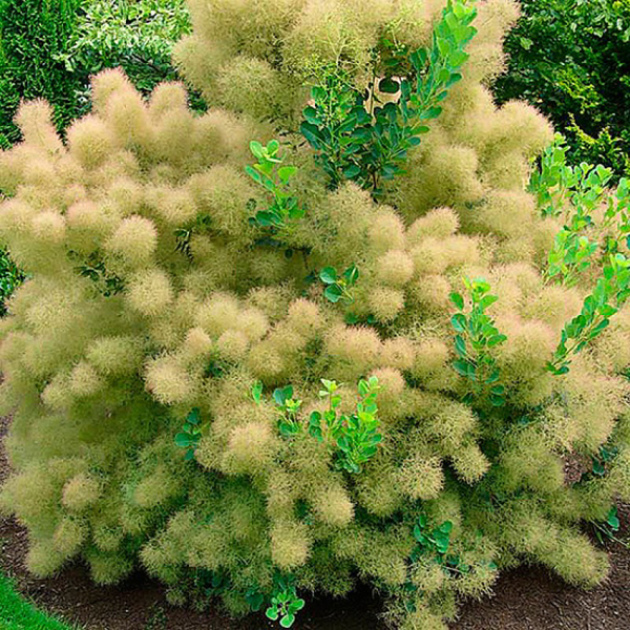
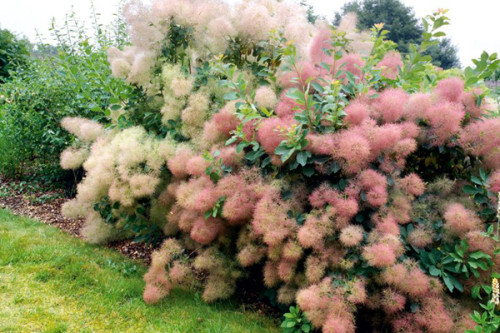

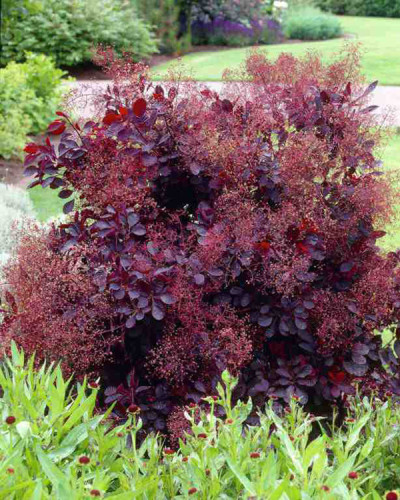
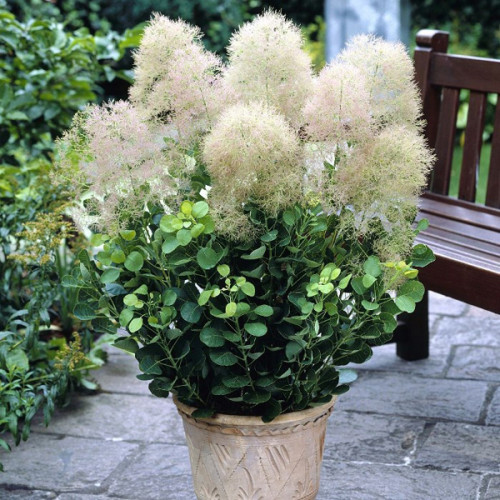
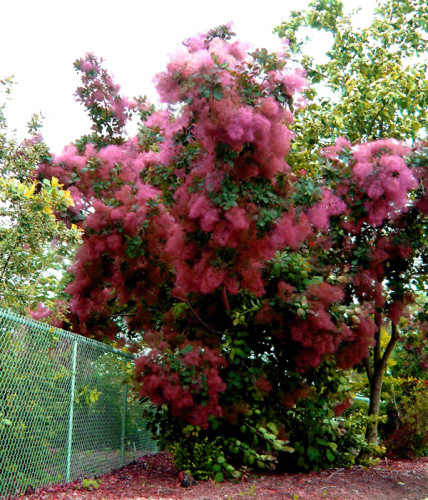
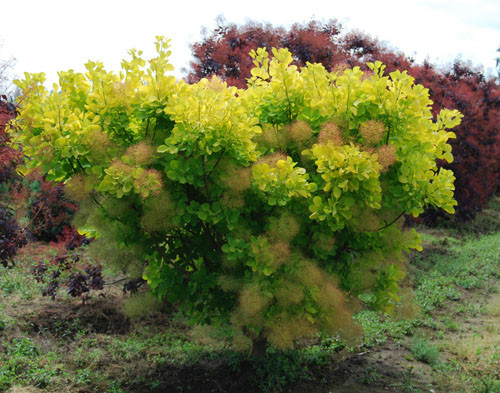
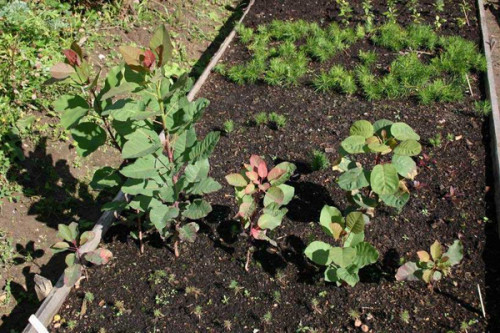
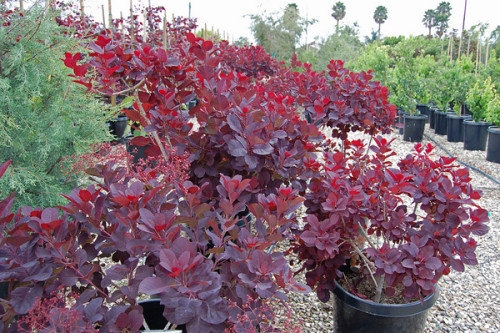
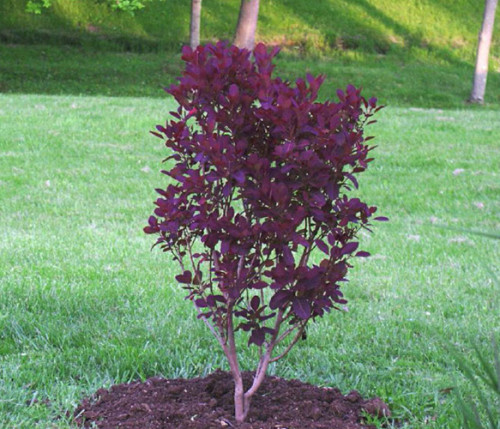
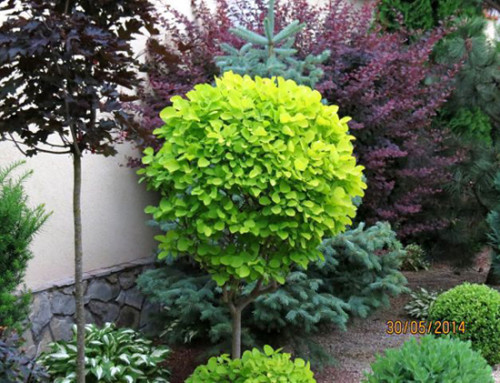
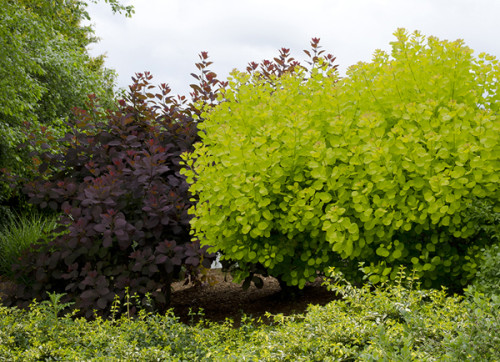
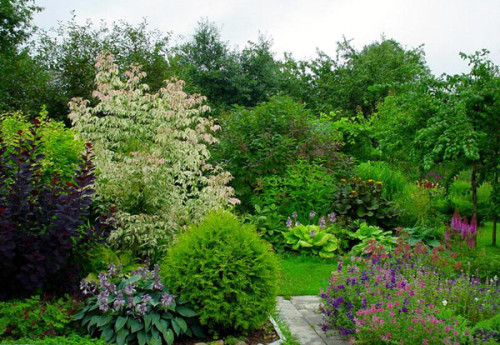
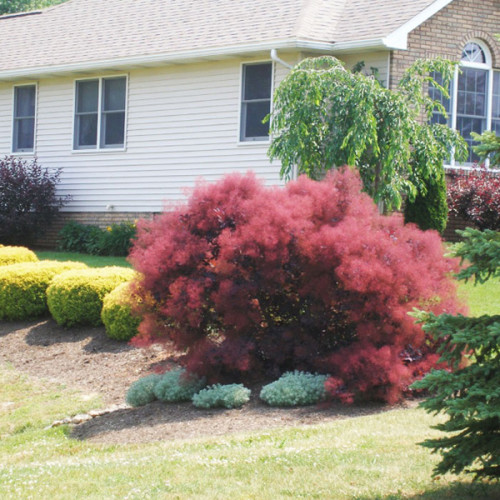












 Start a discussion ...
Start a discussion ...